Key takeaways:
- Resilience in workshops thrives in a safe, open environment where vulnerability is embraced, fostering genuine connections among participants.
- Techniques such as mindfulness, journaling, and promoting a growth mindset contribute to enhancing resilience and personal growth.
- Creating a supportive atmosphere involves establishing trust, setting clear expectations, and encouraging peer support to nurture community and engagement.
- Encouraging participant sharing through personal stories and technology, along with follow-up communication, helps sustain connections beyond the workshop.
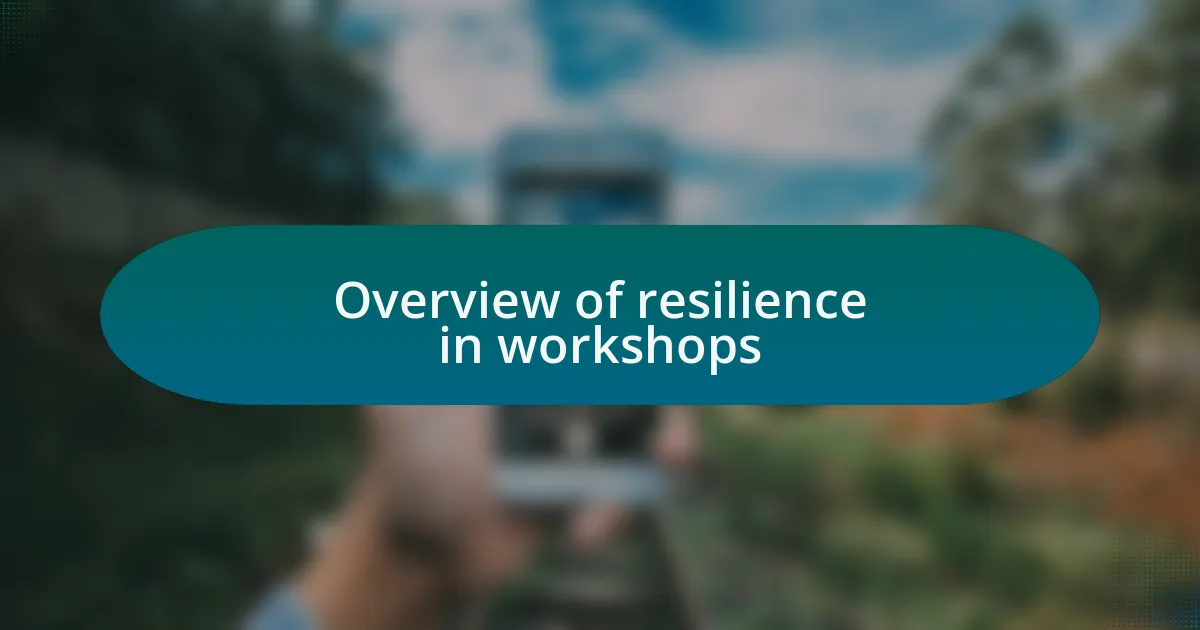
Overview of resilience in workshops
Resilience in workshops is not just about bouncing back from setbacks; it’s about fostering a safe environment where participants feel empowered to express themselves. I remember a particularly impactful workshop where vulnerability was embraced, and participants shared their failures openly. This openness created a bond that allowed us to explore resilience more deeply, as we learned from each other’s experiences.
In my experience, resilience is the cornerstone of personal and professional growth within workshops. When participants feel secure enough to share their fears and challenges, they unlock a powerful potential for transformation. Have you ever noticed how a shared struggle can instantly connect people? I’ve seen individuals go from feeling isolated to forming lasting support networks, all rooted in their shared vulnerabilities.
Moreover, cultivating resilience in workshops involves active listening and empathy. I once facilitated a session where we practiced reflective listening exercises. The atmosphere shifted dramatically; people felt heard and validated, creating a ripple effect of trust and resilience. Such moments illustrate how the right environment can inspire participants to embrace their vulnerabilities, turning challenges into stepping stones for growth.
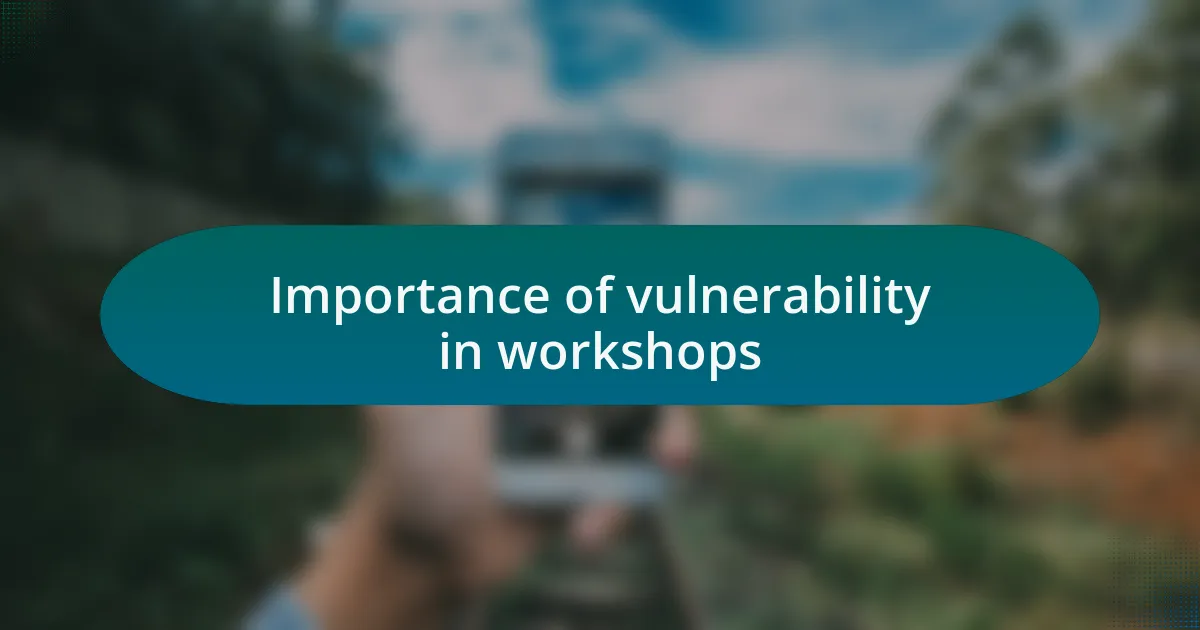
Importance of vulnerability in workshops
Vulnerability plays a crucial role in workshops because it lays the groundwork for genuine connections among participants. I recall a session where a participant bravely shared their struggle with imposter syndrome, an experience many had felt but few dared to voice. That moment turned out to be a turning point; suddenly, others began to share their own stories, and the room buzzed with an electrifying mix of empathy and support that was palpable.
When individuals allow themselves to be vulnerable, they not only invite empathy but also encourage others to do the same. I often reflect on how my own vulnerability in sharing a fear of public speaking within a workshop encouraged another participant to share their anxiety about failure. This reciprocal exchange not only validated our individual experiences but also highlighted the shared human experience of uncertainty.
In my observation, vulnerability often breeds creativity and innovation. I remember a particular brainstorm session where participants felt safe to express outlandish ideas because they knew their thoughts wouldn’t be judged. This environment of openness led to a flurry of creative solutions that likely wouldn’t have emerged if participants had felt the need to present a façade. Isn’t it fascinating how embracing vulnerability can unlock such potential?
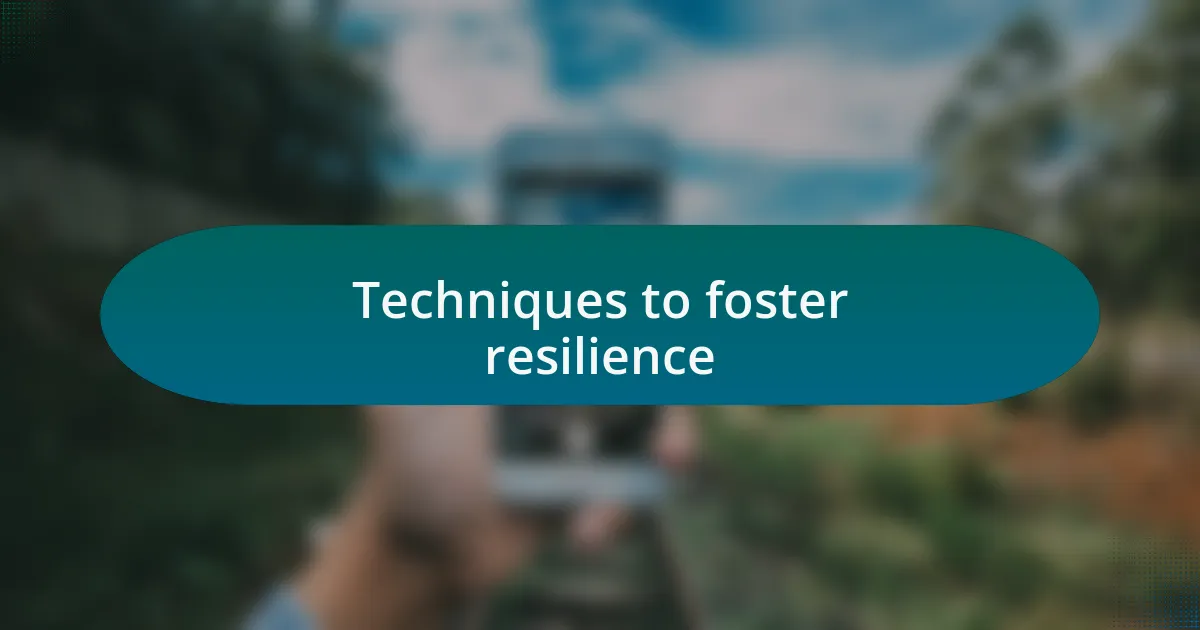
Techniques to foster resilience
One effective technique to foster resilience in workshop participants is teaching them mindfulness practices. I’ve witnessed how a short guided meditation at the beginning of a session can ground everyone, allowing them to approach challenges with a clear mind. This small yet impactful technique not only eases anxiety but also enhances focus, enabling participants to navigate discussions and activities with greater confidence.
Another strategy that I find invaluable is encouraging reflection through journaling. In a recent workshop, I invited attendees to jot down their thoughts after sharing personal experiences. Watching them engage in this process was rewarding; they not only gained insights into their feelings but also discovered patterns in their reactions. Isn’t it interesting how writing can illuminate our inner thoughts, revealing strengths we didn’t realize we possessed?
Additionally, promoting a growth mindset can significantly bolster resilience. During one session, I shared my own journey of overcoming setbacks in my career, emphasizing that failure is not the end but a stepping stone to growth. I encourage participants to view their challenges through this lens, fostering an environment where they feel empowered to embrace difficulties as opportunities for personal development. This shift in perspective can be transformative, don’t you think?
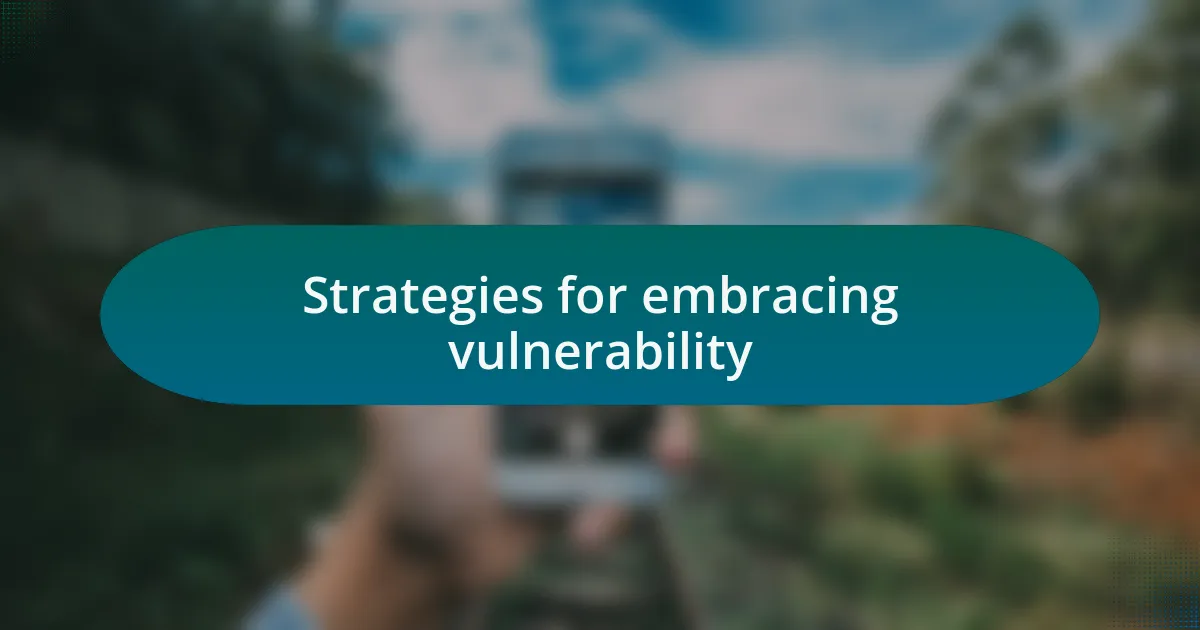
Strategies for embracing vulnerability
When it comes to embracing vulnerability, one effective strategy is to create a safe space for open dialogue. I once facilitated a workshop where I encouraged participants to share their fears related to their professional growth. The moment I opened up about my own apprehensions, an unexpected wave of honesty washed over the room. It’s amazing how authenticity can dissolve barriers, isn’t it? It really allowed everyone to connect on a deeper level, fostering a sense of community that made vulnerability feel less daunting.
Another approach I’ve found impactful is using role-playing exercises. In a recent session, we acted out scenarios where vulnerability might surface, such as receiving constructive feedback. Participants often expressed discomfort, but I guided them through the process. At first, the laughter was a mask for their unease, but gradually, they began to recognize that stepping out of their comfort zones was not only possible but necessary. Engaging with vulnerability in a playful context can shift our perceptions, don’t you think?
Lastly, celebrating small victories when showing vulnerability can make a remarkable difference. I often highlight moments when participants courageously share their thoughts or feelings during discussions. This approach helps them realize that their expressions are valued and appreciated. I’ve seen a participant beam with pride after sharing a personal story, realizing she had taken a brave step. It’s these moments of acknowledgment that encourage further openness and build a culture where vulnerability is not just accepted, but celebrated.
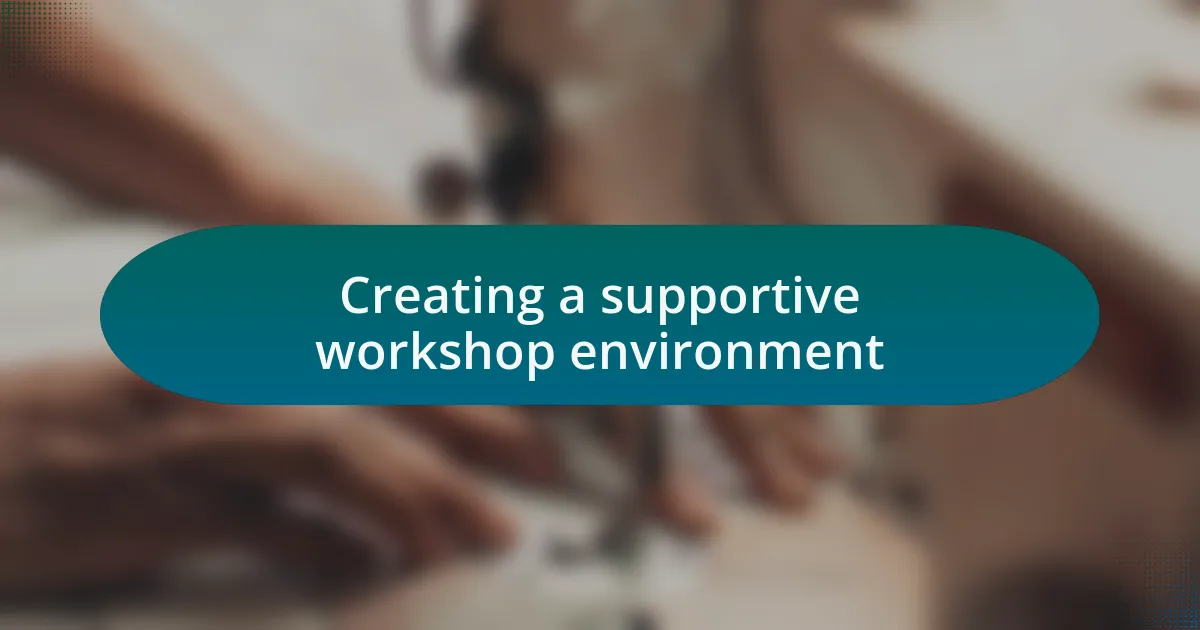
Creating a supportive workshop environment
Creating a supportive workshop environment starts with establishing trust among participants. I recall a session where I arranged for participants to pair up for a “getting-to-know-you” exercise. This simple activity fostered instant rapport and encouraged individuals to share their aspirations and anxieties more openly. It struck me how quickly genuine connections can form when you provide the right setting, don’t you think?
Another key aspect is setting clear expectations for conduct during the workshop. When I set ground rules centered on respect and confidentiality, I noticed a significant shift in participant engagement. They felt empowered to share without the fear of judgment. I remember a time when an attendee expressed gratitude for this clarity, saying it made them feel safe to voice their concerns, which only reinforced the importance of a supportive atmosphere.
Encouraging peer support can dramatically enhance the workshop experience. In one workshop, I introduced small discussion circles where participants could express their thoughts after a group activity. I was amazed at how they rallied around each other, providing encouragement and sharing common challenges. Watching them uplift one another made me realize that sometimes, the strongest support comes from our peers, right? This kind of environment nurtures not only resilience but also a lasting sense of community among participants.
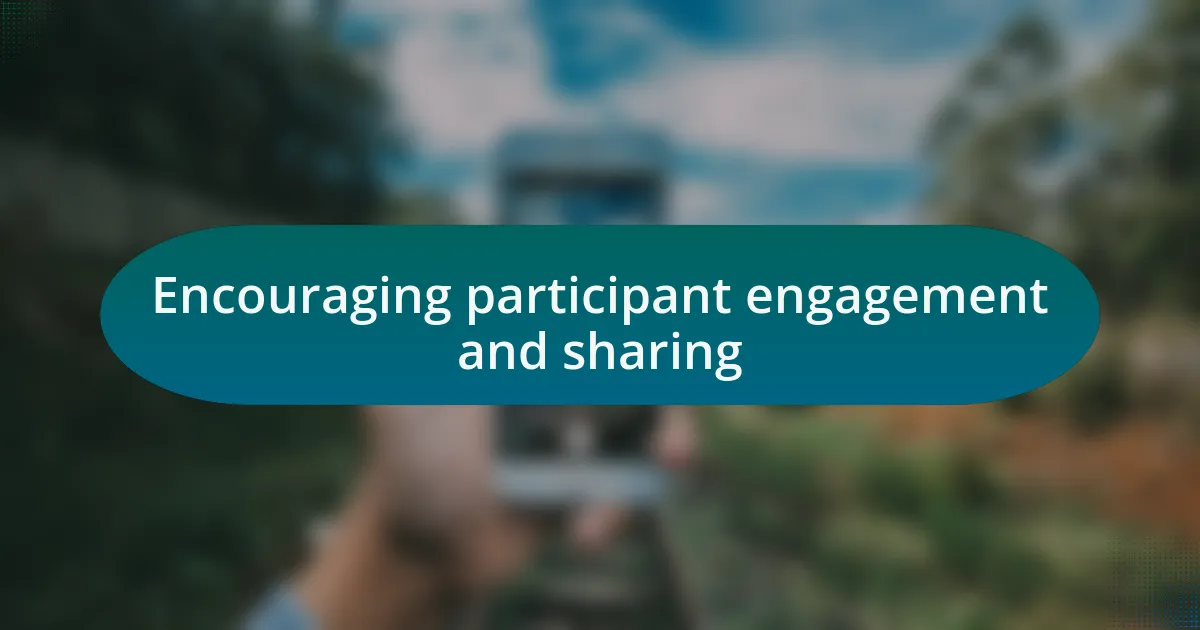
Encouraging participant engagement and sharing
Encouraging active participation doesn’t always require grand gestures; sometimes, it’s the small actions that spark engagement. For instance, during a recent workshop, I invited participants to share their personal stories related to the topic at hand. What surprised me was how one individual’s vulnerable sharing encouraged others to open up, creating an atmosphere of mutual support. Isn’t it fascinating how honesty can create a ripple effect?
Another effective method I’ve found is utilizing technology to enhance interaction. In one workshop, we used live polling to gather everyone’s opinions in real-time. I observed an undeniable buzz in the room as participants expressed their thoughts, which led to deeper discussions. It’s amazing how a simple tool can foster a sense of belonging and validation, don’t you agree?
Finally, I’ve seen the power of follow-up. After a workshop, I send personal messages to participants, inviting them to continue their conversations on a dedicated online platform. This step allows the connections made in the workshop to flourish and evolve, making participants feel valued beyond the event itself. When I see the ongoing interaction, it reminds me that engagement is a journey, not just a moment in time.